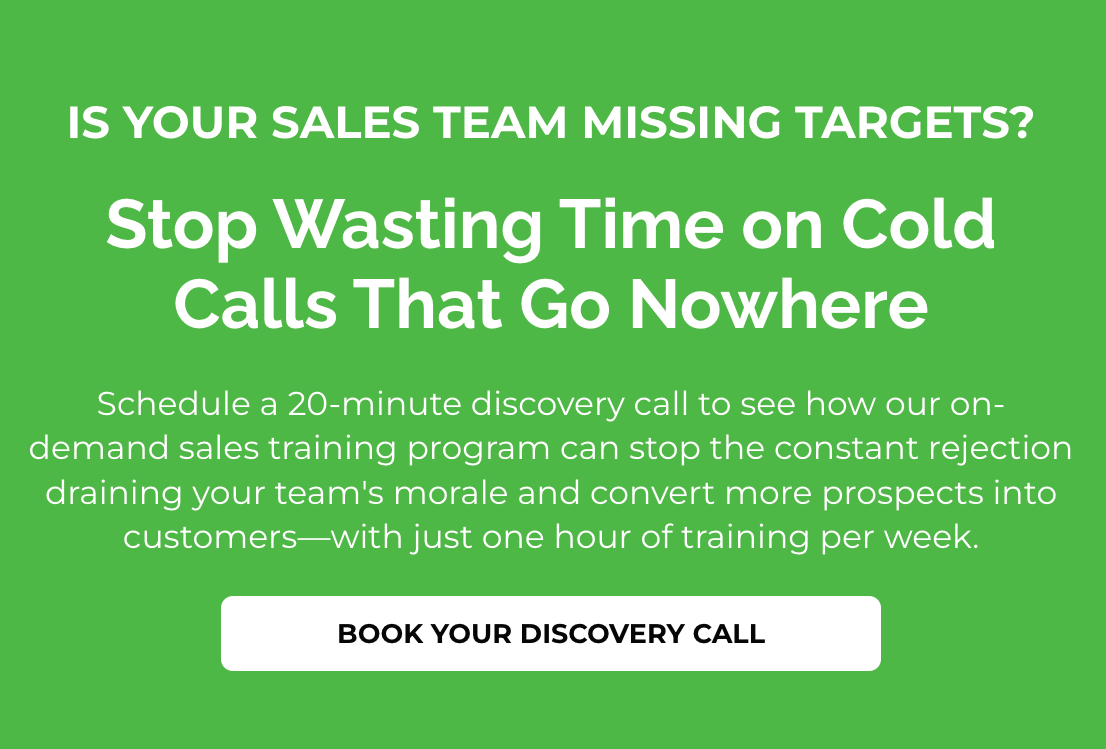How Many Leads Per Sales Rep

Sales Leaders: This Is the Right Number of Leads Per Rep
You’re investing in leads.
Your reps are making calls.
But pipeline still feels flat.
If that sounds familiar, you’re not alone.
Sales leaders across B2B teams deal with the same problem:
Plenty of activity, but not enough real progress.
And one of the most overlooked reasons for this?
Your reps may be working the wrong number of leads.
Why “How Many Leads Per Sales Rep” Is the Wrong Question
Most sales leaders ask:
“How many leads should a rep handle?”
But the better question is:
“How many active leads can a rep consistently follow up with and convert into real conversations?”
Lead management isn’t about dumping lists on reps.
It’s about giving them the right volume to work effectively within a proven outbound framework.
Too many leads and they skim.
Too few and they stall.
Neither is good for building pipeline.
Here’s the Real Answer (Based on 25+ Years of B2B Phone Sales)
After training thousands of sales reps and working directly with their managers, we’ve found that the sweet spot for outbound teams is:
80 to 120 active leads per rep
This is the ideal number of leads per sales rep if your goal is predictable pipeline growth.
“Active” means the rep is either:
Qualifying them,
Following up from a previous touch, or
Actively trying to re-engage
These aren’t cold accounts that haven’t been touched in months.
They’re warm enough to warrant thoughtful, consistent outreach.
What About Dials?
This is where most teams go off track.
They chase dials instead of conversations.
The real benchmark:
60 outbound dials per day or 3 hours of talk time
That’s it.
No need to demand 150+ dials just to hit a number.
What matters is quality effort, guided by a clear framework and talk track.
Your reps don’t need more calls.
They need a reason to call—and a plan once the prospect answers.
Related: How Many Sales Calls Should I Make Per Day?
What Happens When You Get This Wrong
Here’s what you’ll typically see when the lead-to-rep ratio is off:
Too Many Leads Per Rep:
Surface-level touches, no depth
Follow-up gets delayed or forgotten
Good leads go cold before they’re qualified
Pipeline data becomes unreliable
Too Few Leads Per Rep:
Leads get overworked too soon
Reps burn out on non-buyers
Morale dips from lack of progress
You’re forced to buy more leads prematurely
Real Example: The Overloaded Rep
A SaaS client we worked with had a team of 8 reps.
Each one had over 300 “active” accounts in their queue.
Every week, new leads were added automatically.
Sounds like a high-growth system, right?
Here’s the problem:
Most of those leads were being touched once and then buried.
No follow-up.
No tracking.
No accountability.
When we audited the pipeline, less than 10% of the leads had been contacted more than once.
And the reps were frustrated—not because they didn’t want to sell, but because they had no structure to succeed.
Once we trimmed the queue, enforced 80–100 leads max, and installed a structured sales process, win rates jumped by 31%.
How to Implement This in Your Team
If you’re not sure how many leads your reps are truly managing, ask:
How many contacts are reps actively following up with this week?
What’s the average follow-up cadence per lead?
Are leads being qualified, or just touched once and dropped?
Then adjust:
Cap active lead lists at 120 max per rep
Pause auto-assignments until a rep’s queue clears
Give reps a sales framework they can actually follow
It’s Not About Activity. It’s About Process.
Your best reps don’t need motivation.
They need a structure they can trust—
One that helps them manage the right number of leads,
Say the right thing on every call,
And turn conversations into qualified opportunities.
That’s exactly what the SalesBuzz framework delivers.
If your team has the volume but not the results, request a quote here, and we’ll show you how to fix that.

